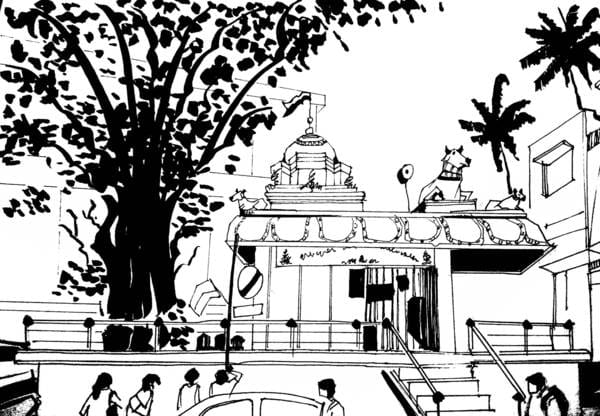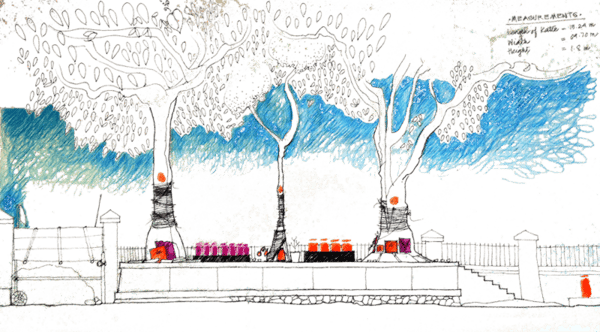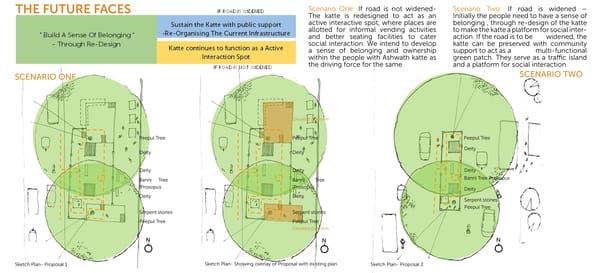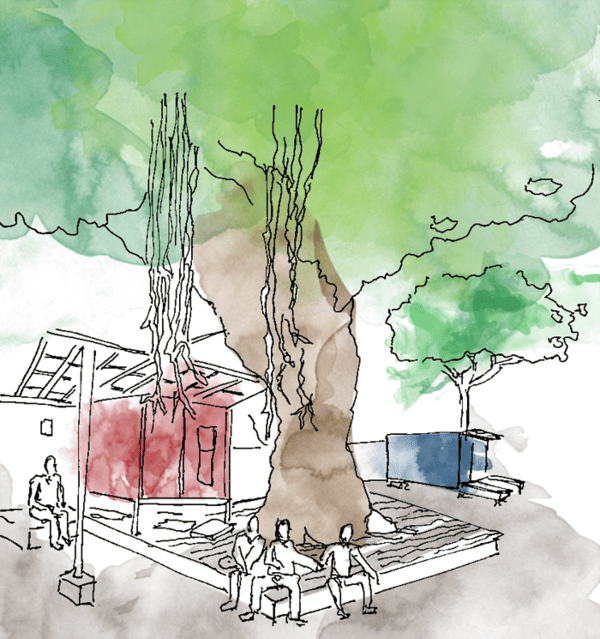In December 2016, a workshop on ‘Trees, Culture & Urban design’ was held in Bangalore as part of CEPT University’s Summer Winter School program. The focus of this 10-day winter school was to study the practice of tree worship in the city. Specifically, it looked at how people generate and sustain community spaces through worshipping the Peepul tree (Ficus Religiosa) shrine with its serpent stones and the raised platform around it, locally called the Ashwath katte. This workshop was based on previous research. The paper can be accessed here: The practice of tree worship and the territorial production of urban space in an Indian neighbourhood. There were 25 participants from the Masters programs at CEPT in Architecture/Urban Planning/Design/Technology. They worked in groups focusing on eight ashwath kattes located in Jayanagar & on Bannerghatta road. The spatial & ritual practices were documented through sketches, photographs, maps & oral history interviews.
Shared below are the summaries of the group projects:
1 Ashwath Katte as an Anchor for Informal Economy
This study looked at an ashwath katte adjacent to the Nagalingeshwara temple in the Jayanagar neighbourhood. The temple and the katte are managed by the Kannada Abhimana Sanga established in 1972. This katte has become an anchor for informal vending and autorickshaw parking. There is an idli-vada vendor, a tender coconut vendor and a chat vendor who cater to construction labourers, autorickshaw drivers, employees of Big Bazaar as well as the residents of the neighbourhood. The vendors receive support from the temple in terms of their water and storage needs. In return, they offer their services for the daily maintenance of the temple.
Group participants: Anuj Nautiyal, Gopikrishnan P and Jeevan Roy

Ashwath katte at Nagalingeshwara temple at Jayanagar
2 Ashwath Kattes and a Growing Metropolis
This study looked at a katte opposite the Meenakshi Mall. This katte is a part of the Meenakshi temple complex and is situated about 150 metres from it. It is an almost invisible space with few devotees worshipping here. The study found that ashwath kattes sometimes exist as physical manifestations of the city’s cultural past but with a muted present. This study attempted to apply Kevin Lynch’s Theory of Good City Form to understand aspects of the katte such as its identity, structure, legibility, unfoldingness and so on. It concluded that for a public space to succeed in the Indian context, it needed to be spatially porous as well as adaptive to temporal changes.
Group participants: Sabrina Khan, Sumathi Mekala and Aradhana Pandey

An Ashwath katte opposite the Meenakshi mall on Bannerghatta road
3 The Ashwath Katte and the Social Life of a Neighbourhood
This study attempted to relate the cultural significance of ashwath kattes to the social lives of a neighbourhood. It found that while some residents interact directly with the katte, for others, the interactions are indirect or incidental. It identified two kinds of users – the regular users who visit the katte at a fixed hour and the incidental users who may visit it on their way to the local market. It found that the routes of the users were either cyclic or linear depending on where the katte was situated with respect to the vegetable vendor, the sweet shop, the flower vendor, the electrical shop or the tailoring shop of the neighbourhood.
Group participants: Pratik Desai, Rohit Raina and Gargi Mishra
4 Ashwath Katte and the Metro Project in Bangalore
The ashwath katte in this study was located next to a bus-stop, a police station and a parking space for towed vehicles. The study found that the canopy of the peepul tree was well utilised by people waiting at the bus-stop, informal vendors and school-going children. There was a possibility that this katte would be demolished if the metro line is built here. The study proposed two options for redesigning the katte in case road-widening takes place. If the road is not widened, the katte is designed such that it allows people to interact better socially. If the road is widened, the katte is planned as a traffic island so that it can continue to exist as a social and religious space.
Group participants: Anuja J, Anju Varghese and Anupama Warrier

The Ashwath katte at a bus stop in Gottigere on Bannerghatta road
5 The Ashwath Katte and a Pedestrianisation Plan
This study looks at an ashwath katte next to the Muthimariamma temple in Kottapalaya in Jayanagar. It is built on a plot allotted by the local municipal authorities for a temple. The family who started the temple are migrants who came here from Tiruvannamalai in Tamil Nadu. Since there are three ashwath kattes within a 400m radius in this locality, this study proposed pedestrianising the street for 4 hours every Saturday. It was felt that this would make the katte as a public space more attractive to devotees, residents as well as informal vendors.
Group participants: Rudra Sharma, Bhargavi Pandya and Kashic Umashankar
6 The Ashwath Katte: How Public is a Public Space
In this study, the katte was studied in three different scenarios: a) It’s relationship with a graveyard, a kalyani and the old village boundary of Gottigere. b) It’s relationship with a residential apartment, a temple and informal vending activities. c) It’s relationship with the municipal corporation office and a nearby vacant plot used for parking. In each scenario, solutions were suggested to incorporate the katte with the surrounding fabric in a more meaningful way.
Group participants: Nisarga K, Rina Chabria, Vasudha Sunger and Nithin Aradhya
7 Somberi Katte as a Social Space
‘Somberi’ means an idle person and the somberi katte was one that was mostly used for casual conversations and informal meetings. This study found that traditional social spaces such as the somberi katte have great potential in bringing people together but are being neglected today. This katte around a banyan tree at Gottigere near Bannerghatta road was earlier the village panchayat katte. People played games at the katte during the Ugadi festival and the Uru habba. However, these social and cultural practices have faded away with time. As the urban fabric has become denser, the usage of the katte has also changed. Since the last few years, it is beggars and homeless people who seem to use the katte more. Next to the katte is a small shop that sells paan, cigarettes, etc. The katte is also used by men while smoking and to hang-out together.
Group participants: Chandan C, Gowtham N and Sachin S

Somberi katte at Hulimavu near Bannerghatta road
8 Accessibility in Urban Space
Accessibility in urban space is an issue that has not been sufficiently addressed in understanding cities. This study looked at how accessibility works in the context of an ashwath katte adjoining a temple in Jayanagar, a residential neighbourhood in Bangalore. It found that there are two kinds of worshippers: direct (who step inside the katte) and indirect (who bow down as they walk by or slow down their vehicle). The study documented both the pedestrian and vehicular activities on the street adjoining the katte. It suggested that pedestrian-friendly street design interventions can reduce congestion and make the ashwath katte a more accessible urban space.
Group participants: Hitav Patel, Palash Shukla and Shivam Mahendru
The visual and interview data & analysis from the workshop were eventually part of the Summer Winter School Exhibition at CEPT University, Ahmedabad held in Dec 2016.